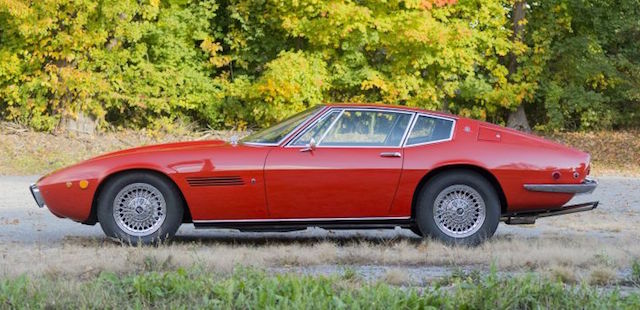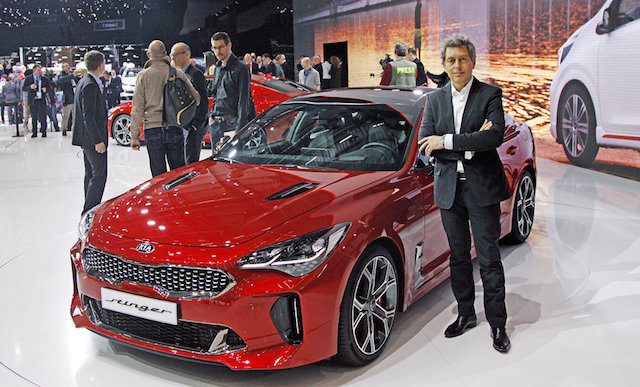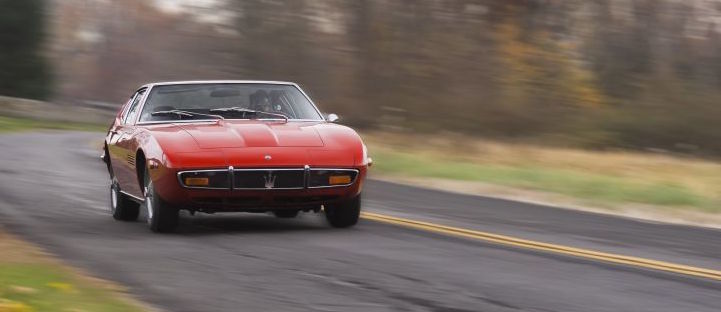
The designer who penned Kia’s four-door, coupe-like Stinger reached back 50 years to Italy and the original Maserati Ghibli (above) for his inspiration.
Kia has already said it used the BMW 3-Series as a dynamic benchmark for Stinger, but its stylist Gregory Guillaume said he aimed at a more glamorous target for the design of the rear-drive car.
“I always had in mind iconic GTs of the early 70s,” he said. “Elegance, power and speed, this Italian Gran Turismo. I had in mind one car always, the original Maserati Ghibli.
“I grew up in France, and I always had in mind those cars were the ones that you would see on the motorway going from Paris to Saint-Tropez. Work hard in Paris, go and have fun in the Cote d’Azur.”
Guillaume (above), the chief designer for Kia Motors Europe, told reporters at the Geneva motor show that the Stinger project began as a ‘what if’ proposition from Kia, how a rear-wheel drive vehicle in the segment might fit with the brand.
“We started, and the reference in that segment worldwide is the 3-Series BMW, it’s the drivers car, the best,” Guillaume said.
“Everybody wants to beat that (3-Series) always, and we said from the start we don’t believe that’s what Kia should be doing.”
Instead, Guillaume’s design led Kia to a more modern interpretation of the classic GT, blending a liftback tailgate, with typical low-roof, long-wheelbase proportions.
“It has a much longer wheelbase than the 3-Series, or any car in that segment because you give the occupants space,” he said.
Not so much vertical space, but knee space, horizontal space. When you sit in the back of the Stinger you are not cramped, you feel quite comfortable.”
The rear-drive Ghibli (above) was designed by a young Giorgetto Giugiaro and unveiled as a two-seater prototype at the Turin motor show in 1966. Two rear seats were added to enable the car to be marketed as a 2+2 coupe when it went on sale in March, 1967.
Under the bonnet was a quad-cam 4.7-litre V8 engine delivering 228kW, a 0-100km/h time of 6.8 seconds and top speed of 250km/h. Standard gearbox was a five-speed manual, although a three-speed automatic was optional.
Two years later the two-seat Ghibli Spyder convertible appeared, available with either a folding tonneau cover or a retractable hardtop. It was followed by the more powerful Ghibli SS coupe and SS Spyder. The SS models used a 4.9-litre V8 delivering 246kW and a top speed of 280km/h, making the SS the fastest Maserati road car.
The Ghibli went out of production in 1973, after a run of 1170 coupes and 125 Spyders, including 25 SS soft-tops.
The Kia Stinger might have been benchmarked against the 3-Series but it’s a larger car and its twin-turbocharged 3.3-litre V6 delivers more power – 272kW against 240kW from the BMW’s boosted 3.0-litre unit.
The Stinger will be available in NZ, although an arrival date hasn’t been confirmed. It is apparently undergoing suspension tuning to suit Downunder conditions, something that Kia and its parent Hyundai does with all its passenger vehicles.
Meanwhile, an Australia design studio has come up with an image (above) of how the Stinger might look if it enters the Supercars championship. Reports across the Tasman say Kia has already talked to Supercars organisers about entry into the category.



